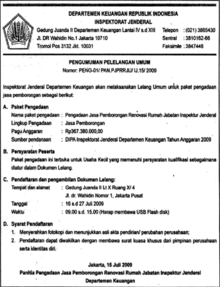
Back طلب العروض Arabic Ausschreibung und Vagob BAR Обществена поръчка Bulgarian Výběrové řízení Czech Licitation Danish Ausschreibung German Licitación Spanish Vähempakkumise päring Estonian مناقصه Persian Tarjouspyyntö Finnish

An invitation to tender (ITT, also known as a call for bids[1] or a request for tenders) is a formal, structured procedure for generating competing offers from different potential suppliers or contractors looking to obtain an award of business activity in works, supply, or service contracts, often from companies who have been previously assessed for suitability by means of a supplier questionnaire (SQ) or pre-qualification questionnaire (PQQ).
Unlike a request for proposal (RFP), which is used when a company sources for business proposals, ITTs are used when a government or company does not require the submission of an original business proposal and is looking solely to award a contract based on the best tender submitted. As a result, whereas ITTs are often decided based on the best price offered, decisions on RFPs may also involve other considerations such as technology and innovation. Both are forms of reverse auction.
At the same time, variants may be requested in an ITT, which allow suppliers to offer proposals which differ in non-essential terms from the supplies or services requested. The European Commission has suggested that requesting variants is one way in which suppliers can be asked to offer more socially responsible solutions to meeting public needs.[2]
Public sector organisations in many countries are legally obliged to release tenders for works and services. In the majority of cases, these are listed on their websites and traditional print media. Electronic procurement and tendering systems or e-procurement are also increasingly prevalent. The European Union states that 235,000 calls for tender are issued annually using its Tenders Electronic Daily system, including those issued by countries in the European Economic Area and beyond.[3]
- ^ Consular reports: Commerce, manufactures, etc, Issues 164-167. United States. Bureau of Foreign Commerce, United States. Dept. of Commerce and Labor G.P.O., 1894. Pg 361
- ^ European Commission, Directorate-General for Employment, Social Affairs and Inclusion and Directorate-General for the Internal Market and Services, Buying Social: a Guide to Taking Account of Social Considerations in Public Procurement, Publications Office, 2011, accessed 30 May 2023, pages 30-31
- ^ European Union, TED: Tenders Electronic Daily, accessed 13 June 2020